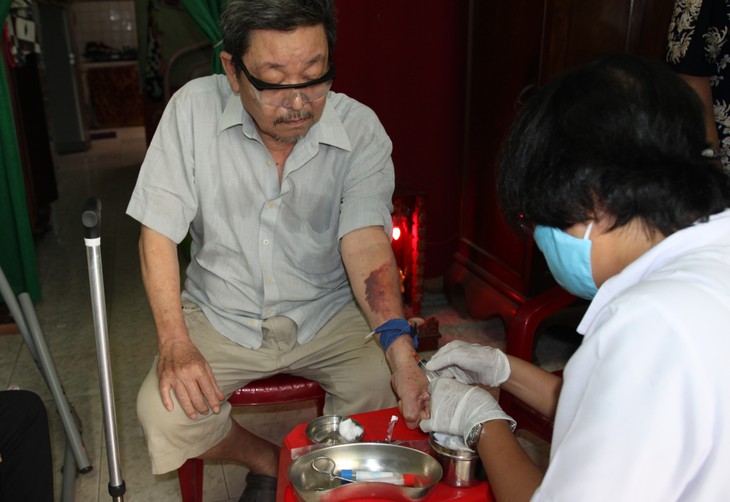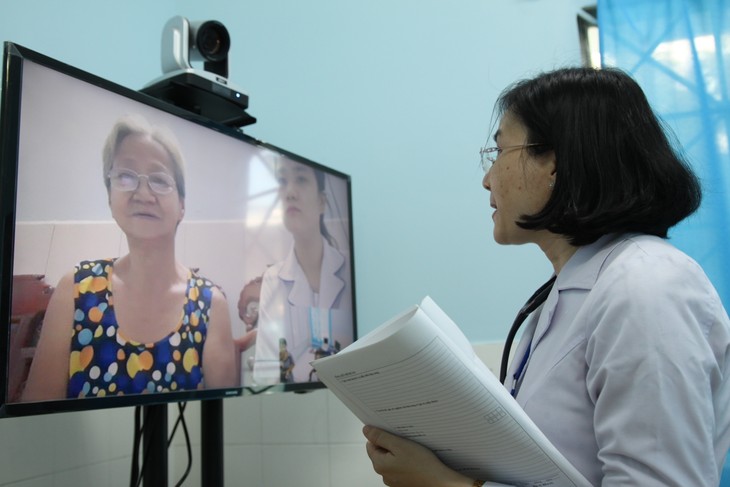(VOVWORLD) - At-home healthcare is a practical delivery model, especially for the elderly and people with chronic diseases. Demand became more urgent during the COVID-19 lockdown. The Medical Center of Go Vap district, Ho Chi Minh City, recently piloted a new health care model which has strengthened people’s trust in the grassroots-level medical sector.
 (Photo: VOV) (Photo: VOV) |
61-year-old Nguyen Thi Nu of ward 16 in Go Vap has hypertension and patella degeneracy, making it hard for her to get around.
In recent months, Nu has been checked at home by nurses from the ward’s medical center who took her blood pressure and performed other tests ordered by Nu’s doctor.
Her results were forwarded to the doctor for a diagnosis and prescription, which was sent to the patient at home.
Nu said, “It’s very convenient. I don’t have to go out, queue up, and wait my turn. I only need to make a phone call and then a nurse will come to my house. She is very nice and kind-hearted. I’m old and have pain in my patella so I can’t walk.”
Doctor Nguyen Thi Thuong, the medical center chief, said Nu was one of many patients to receive at-home medical care.
As a regular patient, Nu has been provided with a treatment regimen and prescription. She doesn’t have to go to the local medical center or hospital for check ups.
Thuong says her health facility provides emergency examinations for between 20 and 30 people a day and vaccinations for up to 70 people. With only 2 doctors, the station is under great pressure and patients have long waits.
“The at-home treatment model allows us to provide both direct checkups at the facility and at-home checkups with the help of nurses. If necessary, we contact higher-level health facilities for further professional assistance. We find the model convenient and the patients seem to be satisfied,” said Thuong.
Doctor Nguyen Trung Hoa, Director of the Go Vap district health center , says the at-home model was first piloted in March with four check-points located at medical stations in ward 8, 12, and 16 and at Nguyen Thai Son General Clinic.
Every day health workers go to patients’ houses to take blood pressure and perform blood sugar tests whose results are sent to a doctor at the medical center for diagnosis and prescription.
 A doctor at the medical center of ward 16 provides remote diagnosis. (Photo: VOV) A doctor at the medical center of ward 16 provides remote diagnosis. (Photo: VOV) |
Hoa said he believes the model will help medical centers manage patients with chronic diseases and reduce the overload for higher-level health facilities.
“One long-term advantage of the model is disease prevention. By treating one patient in a community, we learn how to prevent the disease in other members of the community. This is especially important for infectious diseases like dengue fever, hand, foot and mouth disease, or flu,” Hoa added.
The model has improved primary health care at local medical stations and met the need for elder care with limited human resources at the grassroots level.
Associate Professor Tang Chi Thuong, Vice Director of HCMC’s Health Department, said that from now to the end of this year, a complete program of at-home health care will be set up based on expanding the Go Vap model.
“The model must meet the following requirements: first, it must work for high-priority patients like elderly persons with chronic but non-communicable diseases. If a patient has serious complications, the model should not be applied. Second, patients must strictly follow the doctor’s instructions so that health insurance will cover the hospital fees,” said Thuong.
The Ministry of Health recently approved a program of at-home health care until 2025 under which all health facilities nationwide will receive remote support from higher-level hospitals, reducing the professional gap between central and local hospitals.